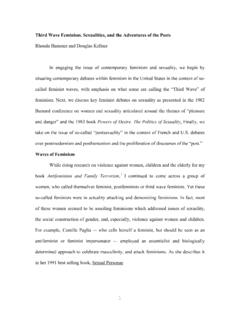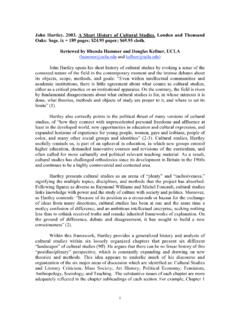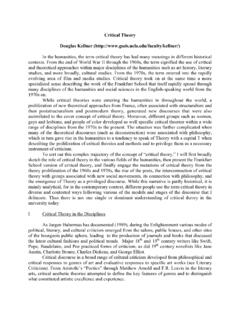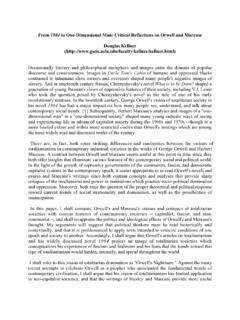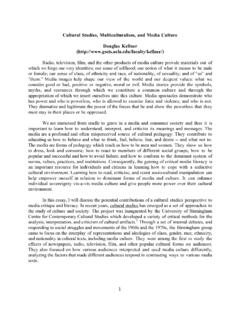Transcription of H.G. Wells, Biotechnology, and Genetic Engineering: A ...
1 Wells, biotechnology , and Genetic Engineering: A Dystopic VisionBy Steven Best and Douglas and "Sometimes I call this reality Science, sometimes I call it Truth. But it issomething we draw by pain and effort out of the heart of life, that wedisentangle and make clear. Other men serve it, I know, in art, inliterature, in social invention, and see it in a thousand different figures,under a hundred I do not know what it is, this something, exceptthat it is supreme." WellsThe writings of Wells offer a highly dialectical vision of science andtechnology as providing both tremendous benefits and dangers for human Aprolific writer of novels, short stories, and works of non-fiction, Wells praised thewonders of science and technology, mostly in his non-fiction (Wells 1902 and 1938), butalso sketched out potential horrors in his science-fiction writings (Wells 1996a, 1996b,and 1996c).
2 While he frequently championed science and technology as great vehicles ofprogress, he also provided prescient warnings of their misuse and abuse. In particular, heanticipated that science and technology could create mutations in the human and generatenew species, and that human beings were thus potentially a transitory phenomenon thatcould vanish like dinosaurs or imagined that the coevolution of science, technology, and human beingscould alter the forms of space and time, the patterns of human life, and produce bothmarvels and monsters. A believer in evolution, he imagined that the human species couldmutate in surprising and discontinuous ways, anticipating positive leaps and negativeregressions in the human adventure. Evolutionary perspectives are thus a major theme inWells' work which carried speculation on the fate of humanity into the realm of what weare calling the "fifth discontinuity.
3 " Wells and the Fifth DiscontinuityThe notion of the "fourth discontinuity" developed by Mazlish (1993) involvedthe perception that humans are not qualitatively different from machines and areimploding into machines. The fifth discontinuity, however, envisages that humans arecreating, or that there could exist, a superior species and that humans no longer would bethe sovereign power of nature. Such a condition would emerge if humans becomesubordinate to machines and the outgrowth of their labor. This discontinuity wouldsuggest that the human race may degenerate or disappear as an offspring of evolution, orthat a more intelligent and powerful alien species may appear to enslave or destroyhumans. All of these possibilities were foreseen by Wells who emerges in our analysis asthe prophet of the fifth Mary Shelley's Frankenstein can be read as an early modern response to theexcesses of science and technology (see Best and Kellner 2001), Wells is thoroughlymodern, residing in the world of automobiles, radio, airplanes, X-rays, movies, andwonder drugs.
4 In some ways, Wells was a modernizer, reacting against the conservatismof the Victorian age and he saw science and technology as progressive forces. In anamazing anticipation of the Internet, Wells imagined a World Brain or WorldEncyclopedia that would contain all existing knowledge:an immense and ever-increasing wealth of knowledge is scattered aboutthe world today, a wealth of knowledge and suggestion that --systematically ordered and generally disseminated-- would to solve all the mighty difficulties of our age, but that knowledge isstill dispersed, unorganised, impotent (1938: 47).To remedy the situation, Wells proposed that all knowledge in the world be gathered inthe World Brain, "a new world organ for the collection, indexing, summarising andrelease of knowledge." This project would entail "the creation of an efficient index to allhuman knowledge, ideas and the creation, that is, of a complete planetarymemory for all mankind.
5 " Projecting a technopopulism, Wells insists: "the whole humanmemory can be, and probably at a short time will be, made accessible to the time is ripe for a very extensive revision and modernisation of theintellectual organization of the this synthesis of knowledge is the necessarybeginning to the new world. [The world] has to pull its mind together," through this newkind of "mental clearing house, the World Brain" (1938: 59, 60, 61, 26, 64, and 49).2 While Wells could thus perceive science and technology as progressive forces, hewas also aware of the dangers of scientific experiment and technological developmentdevoid of ethical vision and concern. In particular, Wells' short stories and novels exhibithis subtle and dialectical conceptions of science and technology. In his most popular andinventive stories (1996c), a similar formula is at work: his characters encounter amarvelous scientific or technological breakthrough or anomaly that could producepositive and wondrous results or could generate a disaster -- and often the outcome isambiguous.
6 This vision captures the contradictions and tensions of science andtechnology, which can yield both gains and losses. For example, in "The Stolen Bacillus"(1894) a scientist works on discovery of a cure to cholera, but the theft of his bacillus bya deranged anarchist could threaten the lives of the city, showing science capable ofproducing both cures to disease and new agents of destruction (1996c: 26-33). Likewise,in "The New Accelerator," it is not clear at first that the wonder drug which acceleratesthe characters' sense of time will be a blessing or a curse, though by the end of the story itappears to be catastrophic (1996c: 362-377).Science fiction traditionally has articulated both utopian yearnings that scienceand technology would take us beyond earthly limitations into exciting new cultures andworlds, and worries that these forces would create monstrous and destructive artifacts andeffects.
7 Hence, the best SF portrays the adventures and grandeur of science andtechnology, as well as warning of its perils and dangers. Furthermore, it is SF, wesuggest, that maps the magnitude of the changes that scientific and technologicalrevolutions are currently generating -- although we are arguing that both SF and criticalsocial theory are necessary to illuminate the depth and magnitude of the turbulenttransformations of the postmodern delivered what Isaac Asimov (1979) called "The Science-FictionBreakthrough" by portraying the extreme discontinuities with the past that science andtechnology were producing. Wells pursued the "what if" logic of modern SF to newdimensions, conceiving radically other universes and beings, and anticipatingdevelopments in which humans are forced to discern that they are no longer the dominantspecies, just as earlier they were forced to recognize that they were not the center of theuniverse (Copernicus), a wholly unique species (Darwin), the rational master of theirpsychological life (Freud) or superior to machines (see the discussion in Best and Kellner2001, Chapter 3).
8 3 There are at least three domains of the fifth discontinuity, most of which Wellsanticipated. First, there exists the possibility that machines might be created that are moreintelligent than human beings (see Paul and Cox 1996; Morevac 1988; Kurzweil 1999).In one variant of this scenario, humans will assimilate technology that will dramaticallyincrease their intelligence, longevity and powers, thus in effect creating a new superiorposthuman species. In another scenario, humans will create machines, "mind children"(Morevac), or "spiritual machines" (Kurzweil), which will constitute an ascendent speciesof intelligent life (see the discussion in the following section). In these visions, humanbeings either merge with the computers and robots they are creating, or they becomeinferior and , humans could create a new species through biotechnology and geneticengineering that are more advanced than humans, as was anticipated in VictorFrankenstein's creation of new life forms, and Wells' science fiction.
9 Whereas the firstvariant is rooted in conceptions of artificial intelligence, computer technology androbotics, the second conception is grounded in biotechnology and Genetic of suprahuman beings or new species created through biotechnology rangefrom human replicants that are similar to humans but potentially superior, as in the filmsBlade Runner (1982) or , to the creation of murderous alien species as in the Speciesfilms. These films provide cautionary warnings that current technologies of geneticengineering and artificial intelligence might produce entities that threaten humandominion and new a new technospecies may someday come about through artificialintelligence and biotechnology , and dozens of transgenic species in fact already exist, thethird type of fifth discontinuity is an entirely speculative possibility. This form of radicaldecentering of human beings would emerge if aliens appeared that are superior to humanbeings, a fear popular in SF literature and TV shows like The X-Files, Dark Skies, Prey,and First Wave.
10 According to the celebrated "Drake's equation" which calculates thechances of alien life existing, the infinite time and space of the universe provides goododds that extraterrestrial beings exist and scientists like Carl Sagan have affirmed thepossibility, although these speculations have been disputed (see Best and Kellner, 2001,Epilogue).In War of the Worlds (1898), Wells imagined that superior alien races couldtravel to earth and defeat and destroy humans, thereby decentering and dethroninghumanity as the highest form of evolution. In the first major tale of interplanetarywarfare, Wells instilled in the popular psyche a fear of aliens that remains a majorconstant of a tradition of SF and media culture. A pointed satire of imperialist invasionthat elicited similarities to destructive forms of colonization in modernity, Wells' storyprovided a cautionary warning that imperialist forces themselves could be made subjectto unknown and calamitous counterforces.
